We arrived in Charleston, South Carolina this past Monday without a plan as to what we were going to be seeing. Sure, we knew that this was the location of Fort Sumter, the place that received the first shot of the Civil War. Beyond that, we knew little of Charleston’s story. By pure luck, we opted to stay at the same KOA that our friend Kathy was working at.
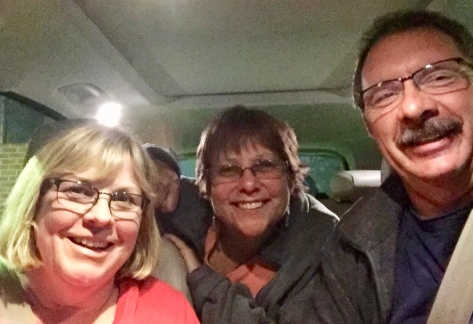
You may recall that we had met her while working at Amazon, and we also caught up with her in the Black Hills last September. On this occasion, she was heading out the following day to her next KOA gig in New York…one we are staying at later in our trip. We went out to a local pizzeria and she filled us in on a few things to see in town.
On Wednesday, our friends from Melbourne Beach Mobile Park, Brenda and Jim, met us in Charleston’s historic district.
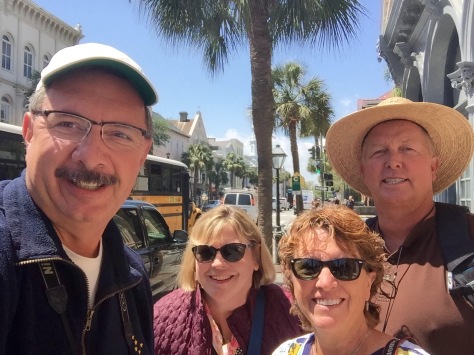
Brenda’s blog, No More Sticks and Bricks, details their journey as fulltime RVers. Definitely check it out. The four of us had lunch at the Brown Dog Deli, then we set out to do some exploring!
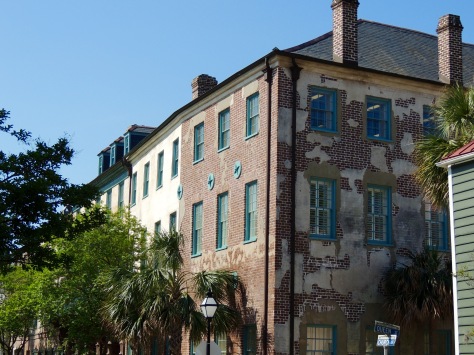
All throughout the town, we saw these plates with nuts in the center of them. They are called earthquake bolts, and they were put there following the 7.0 quake in 1886 that rocked the city. They are rods that run completely through the buildings that help straighten the bulging walls.
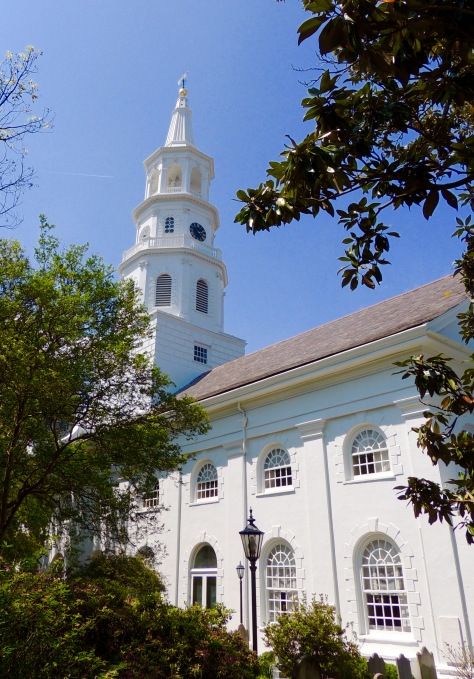
This is St. Michael’s Episcopal Church. It is the oldest religious structure in Charleston, dating back to the 1750’s. It’s graveyard holds two of the signers of the U.S. Constitution: John Rutledge and Charles Pinckney.
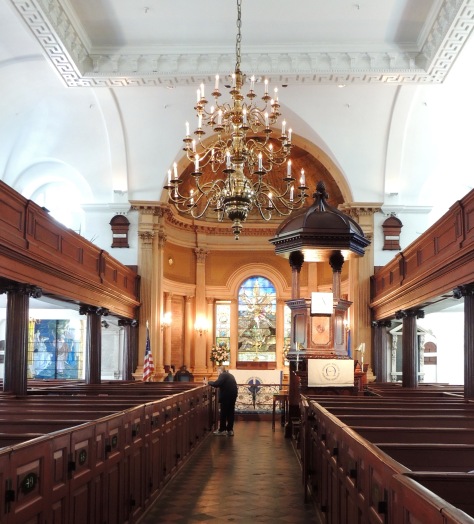
Both George Washington and Robert E. Lee attended services here, each sitting in Pew #43, some 70 years apart.
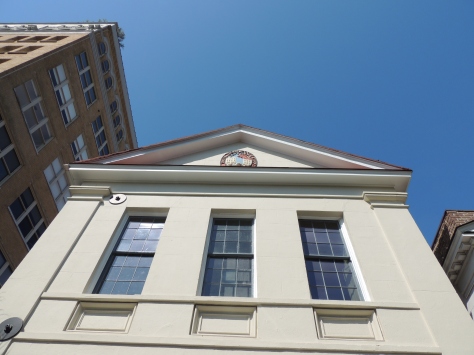
On State Street, we found the Union Insurance building. Back in the day, each insurance company in town also had their own fire truck. See that seal at the top of the building? Each insured home displayed the seal from the company they were insured by. While all companies would respond to a fire, only the one that insured the home was responsible to fight the blaze.
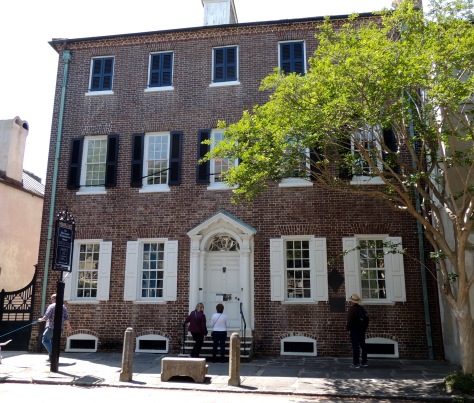
Jim, Brenda and Diana are admiring the Heyward-Washington house. Thomas Heyward, signer of the Declaration of Independence, owned this home. George Washington stayed here on his visit to the city in 1791.

Twice we passed by St. Phillip’s Episcopal Church, but were unable to view the interior. The first time, a funeral was in progress and the second time it was closed. This building was built in the 1830’s, after fire destroyed its predecessor. In 1861, the bells in the steeple were donated to the Confederate Army to be made into munitions. They were not replaced until 1976.
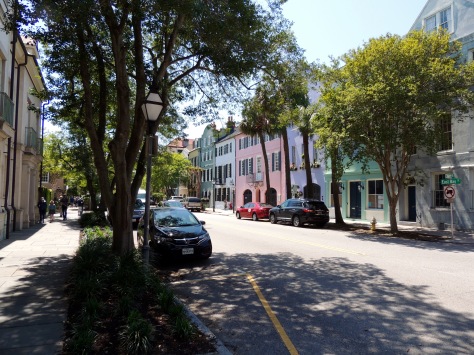
On Bay Street is this collection of houses known as Rainbow Row. Alternating pastel colors adorn each home. This concludes our tour of the upper part of town with Jim and Brenda. What a fun day!
On Friday, Diana and I decided to check out the lower portion of the historic district.

This beautiful building is the Circular Congregational Church. Part of the United Church of Christ, this progressive congregation has been meeting at this site since 1681. The current building was built after the earthquake.
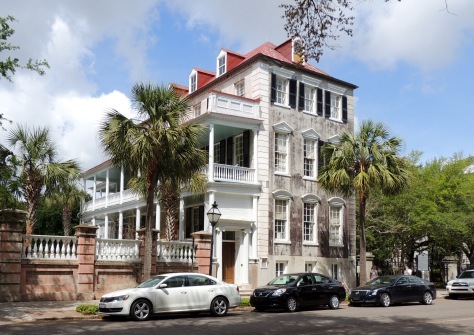
We also saw several of these ‘single’ houses, meaning they were only one room wide. This allowed the sea breezes to flow through the homes. Note the front door. It actually opens to the porch, thereby allowing privacy for the homeowners when they were sitting outside.
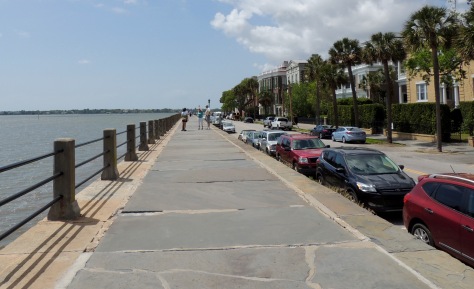
Overlooking the harbor is the High Battery. Named for the artillery that was mounted there during the Civil War, this raised walkway allowed for the construction of lower Bay Street.
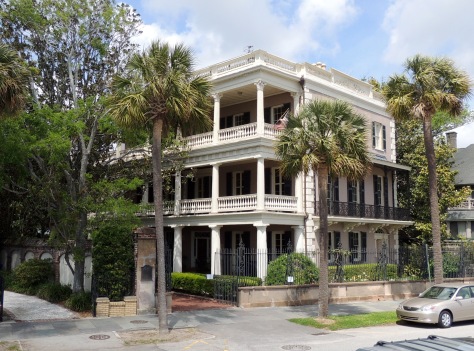
One of the many homes across from the High Battery is the Edmondston-Alston house. It is from the second floor porch that Confederate General P.G.T. Beauregard observed the shelling of Fort Sumter, which can be easily seen from that vantage point.
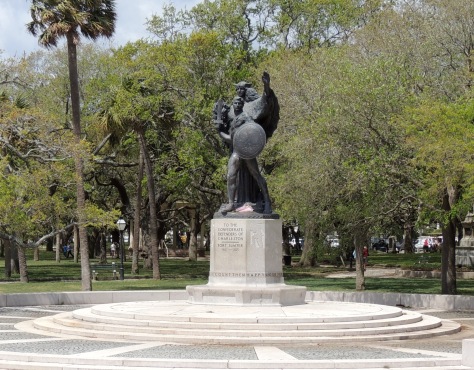
Further down the street is this monument to the men of the Confederacy. The figures are looking directly across the harbor at Fort Sumter.
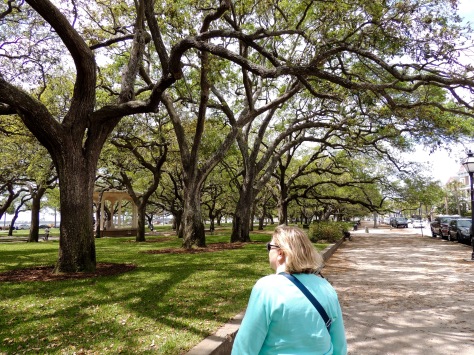
White Point Garden sits at the extreme south end of town. The beautiful park has a checkered past, as Stede Bonnet and 50 of his fellow pirates were hung here in 1791. They were left hanging for days as a successful deterrent to piracy along these shores. It was also the site of heavy artillery during the Civil War.
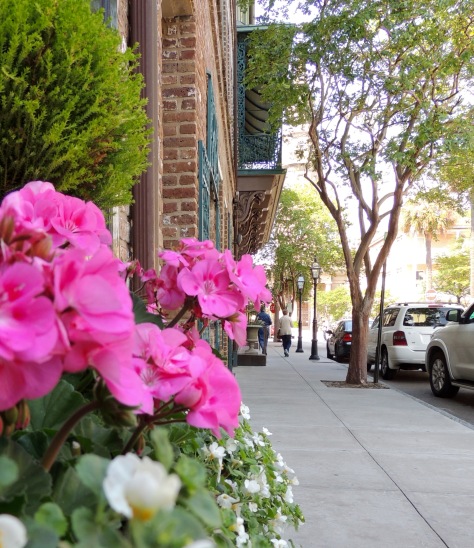
That wraps up our tour of the historic district in Charleston. Next up is a tour of Forts Sumter and Fort Moultrie, both including some surprises found there that we weren’t aware of. Be sure to stay tuned for that adventure in our next post!

Interesting visit. Never knew about the seals on top of the buildings. Nice that you were able to meet up with Kathy again, love this life where you can meet up with friends and explore towns all over the country!
LikeLiked by 1 person
So much history on this coast, Jim. Both Savannah and Charleston are very walkable. I was surprised how uncrowded Charleston felt, even being full of tourists. Maybe because the streets are narrower; people just parked their cars. Very relaxed, for sure.
LikeLike
Charleston is such a beautiful city. We enjoyed all of the old buildings and lush gardens. Great information about the earthquake bolts and fire seals.
LikeLiked by 1 person
Thanks, Bonnie! So much history to soak in.
LikeLike
Love Charleston and that is where my daughter and son in law live. I didn’t know that about the insurance companies and fire departments. Super interesting. If you saw the High Cotton restaurant downtown that is where my daughter works!
LikeLiked by 1 person
We didn’t see High Cotton, but they sure have a charming place to live! We noticed that even though the “y’all” is everywhere, there was much more of a Midwestern accent to the voices we encountered.
LikeLike
Another wonderful post Jim. Love the info on the insurance company fire trucks – guess they had a vested interest in saving as much as possible!! The old churches are beautiful, too bad you couldn’t get inside. Just another good reason to come back 🙂 We must find our way to this corner of the country!!
LikeLiked by 1 person
Thanks, Jodee! I really get a kick out of those quirky tidbits like that. 😊
LikeLike
You wrote your friend Kathy was heading out to her next KOA gig in New York. Is she working from one KOA to the next? Kind of like working for one company?
Charleston is big time on our list. Been bookmarking other’s blogs about the area and hope to add a few of your notes from the visit, as well as a bunch more during your trek north. Bookmarks such as going to Shem Creek Sea Food to eat. Also visiting the Yorktown Carrier and a diesel sub. Wish it was the original Yorktown that was sunk at Midway. But, still looking forward to touring the big ship.
I’ve got no idea if Ranger Rick Hatcher is still working at Fort Sumter. If he is then please feel to drop my family name and bet you will get a special tour. Rick was good friends with my father, Doug Seneker, when he worked at Wilsons Creek Battlefield in Missouri. He is a good guy. I know he was there in 2011. Here is a Facebook dated October 2017 with Rick:
Mark Seneker
LikeLiked by 1 person
Yes, KOA has their own work camper program. She really likes it.
Our Fort Sumter tourboat took us directly in front of the Yorktown. I’ll include the photo for you in our next post. We didn’t get to see Rick, but we met several other rangers this week. Our tours are complete, and tomorrow is laundry before heading north Monday. You will absolutely love it here, Mark!
LikeLiked by 1 person
So glad we got to meet up! It was a fun day and we look forward to seeing you guys down the road again at some point. For sure MBRV Park where we will have to get together more often. 🙂
LikeLiked by 1 person
We had a great time with you and Jim, Brenda! Looking forward to the next time!
LikeLike
While Charleston is my birth city (I only lived for a short time while my father was in the Navy), I never explored until we went fulltiming. It is a beautiful old southern city. I love Rainbow Row! Interesting info on the seal. I didn’t know that. Thanks for sharing!
LikeLiked by 1 person
What a beautiful place to come into this world, Pam! We sure enjoyed our time there!
LikeLiked by 1 person
I can’t wait to visit Charleston! What a wonderful post.
LikeLiked by 1 person
Thanks, Dawn!
LikeLiked by 1 person